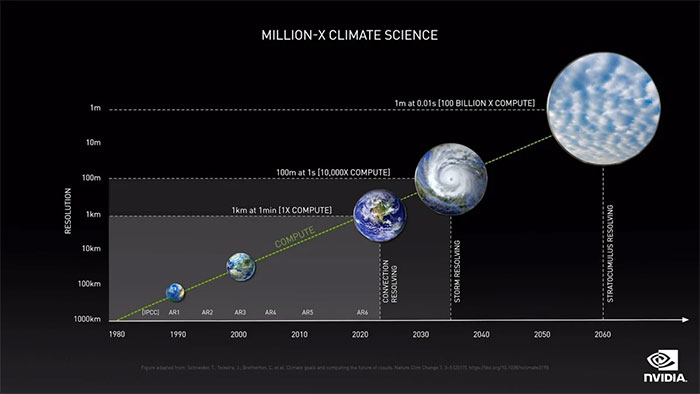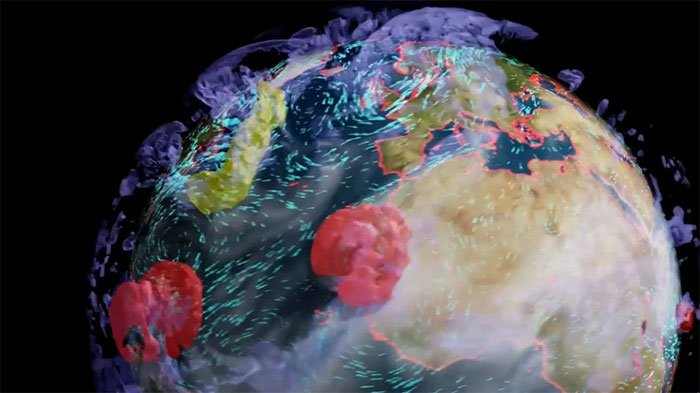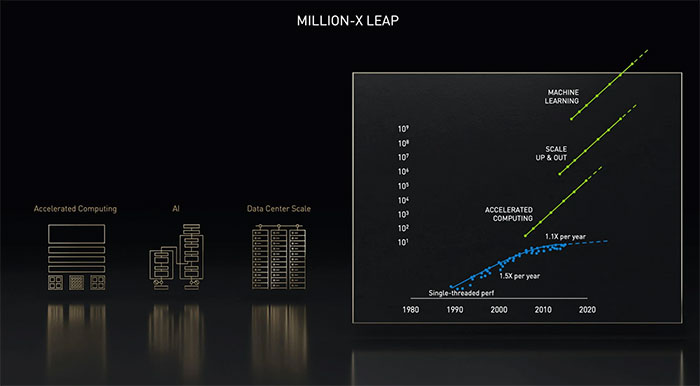At the recent GTC event, Nvidia unveiled the Earth-2 project, the world’s most powerful AI supercomputer, a 3D simulator of Earth with flexible and detailed modeling capabilities to help humanity assess climate change more accurately and predict future natural disasters.
The Earth is getting warmer. The past seven years can be considered the hottest in human history. Since the period from 1850 to 1900, greenhouse gas emissions from human activities have caused the average annual temperature of our planet to rise by approximately 1.1 degrees Celsius. What we are experiencing is truly alarming, with a series of extreme weather conditions such as prolonged droughts, heavy rains, violent storms, and devastating floods. Natural disasters, which were already harsh, have become more brutal and intense than ever before.
However, addressing climate change is not simple and cannot be achieved overnight. Just a few years, or even a few decades, are not enough for us to feel the positive changes. Nevertheless, to ensure that Earth-saving and environmental protection campaigns proceed in the most effective manner, we need to foresee the future and accurately perceive what will happen.
 NVIDIA aims to use the “digital twin” of Earth to predict the future.
NVIDIA aims to use the “digital twin” of Earth to predict the future.
It may sound fictional, but this is exactly what NVIDIA is pursuing. At the GTC event held in mid-November, they revealed the Earth-2 (E-2) project, the world’s most powerful AI supercomputer, a “twin brother” of our Earth on the Omniverse platform, a 3D simulation of the blue planet capable of making more accurate predictions about climate change.
According to CEO Jensen Huang, E-2 will combine three advanced technologies: high-speed GPUs, deep learning, and AI supercomputing, along with a massive database about Earth. All of this will support the creation of ultra-high-resolution climate prototypes that are the most accurate.
In fact, there are many models like E-2 that exist, capable of determining factors such as air pressure, wind intensity, and temperature to create appropriate equations, providing an objective view of climate patterns in specific areas. These areas will be represented in a 3D grid format. The smaller the area, the more accurate the calculations will be, and the simulation will become more realistic until it becomes unusable.
In other words, weather models need to solve more equations to achieve higher resolution. However, the more equations are processed, the slower and less efficient the model becomes, gradually rendering it useless. This is a problem that most current climate models face: a lack of detail and accuracy.
NVIDIA’s solution is to create a supercomputer that is larger, better, and faster. On the company’s blog, Mr. Huang wrote: “We need higher resolution to accurately simulate changes in the global water cycle. We need meter-scale resolution to simulate how sunlight is reflected back into space by clouds. Scientists estimate that such resolutions require computational power millions to billions of times greater than what we currently have.”

Earth-2 will address the lingering issues in similar simulators.
Returning to E-2, the digital twin of Earth, it is created to promote actions that both mitigate climate change and reduce its negative impacts on nature and humanity. Extreme weather phenomena such as hurricanes, wildfires, heatwaves, and flash floods are becoming increasingly unpredictable and devastating.
This situation could be somewhat improved if we could predict such disasters more accurately in the future. Mr. Huang hopes that NVIDIA’s model can forecast extreme weather changes in various regions around the world for decades ahead. This way, humanity will have time to implement timely solutions, reasonable evacuation policies, or appropriate construction projects to adapt to such climatic conditions.
E-2 will also be used to find reasonable solutions, simulating various plans to determine which option delivers the highest efficiency at the lowest cost. This is considered one of NVIDIA’s largest projects in recent years. Mr. Huang stated: “All the technologies we have created so far are essential to realize E-2. I am really looking forward to the new features and more significant tasks that this model can undertake in the future.”
Not Just About Climate Change

The combination of various technologies has enabled NVIDIA to create the most advanced and efficient Earth simulator, while also helping them address many issues related to the speed of supercomputers, especially in research projects with massive databases.
Similar to E-2, NVIDIA has focused on developing three core technologies: high-performance computing, AI, and the scale of data centers. This not only helps them simulate Earth but also creates many digital twins of cities and factories around the world. This large-scale simulation technology is still very new and full of potential.
Additionally, the research team at NVIDIA, Caltech, and the startup Entos successfully combined machine learning with physics to create the OrbNet program. As a result, Entos can accelerate its drug discovery simulations by 1000 times, completing work that would typically take over three months in just about three hours.


















































